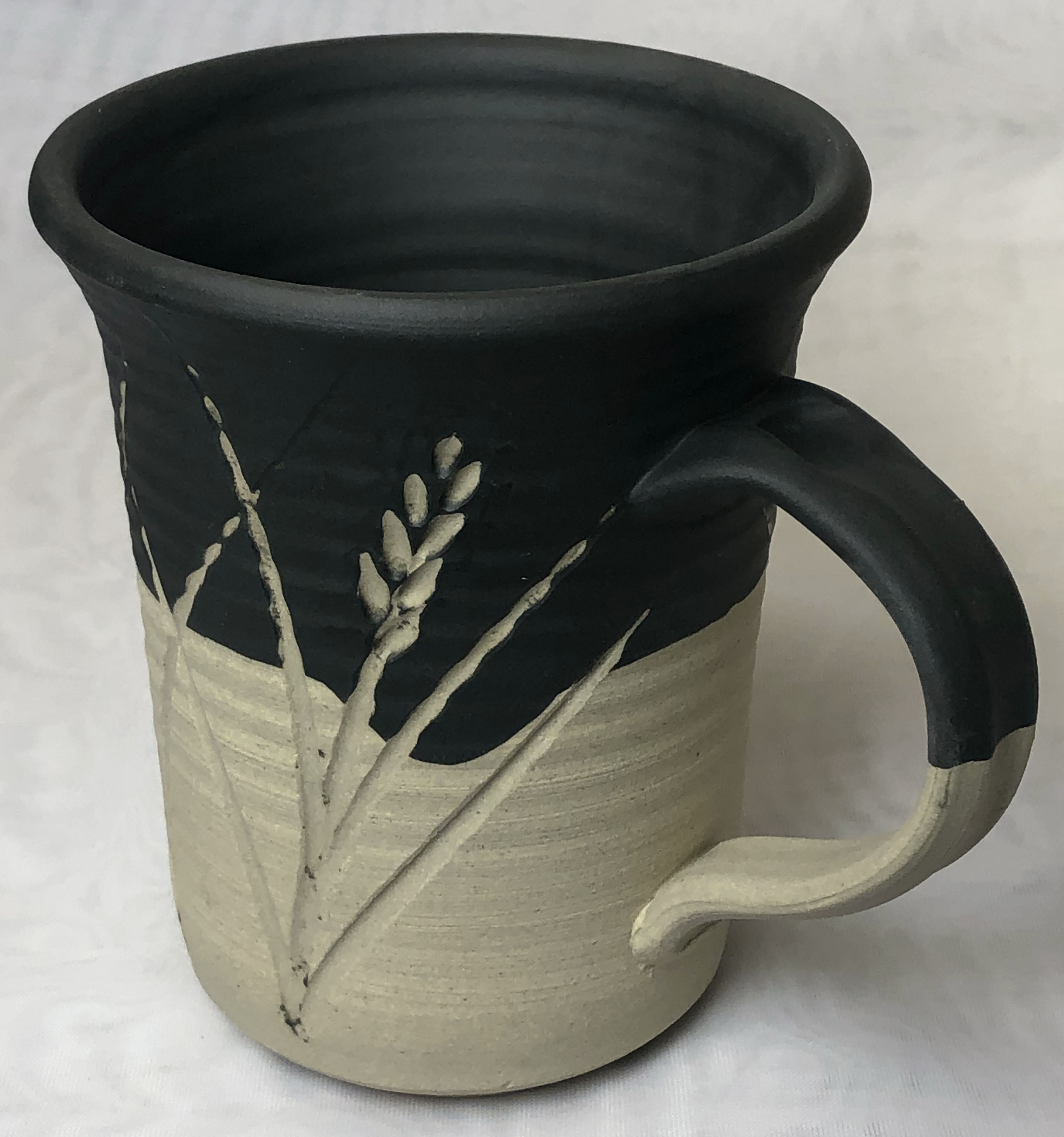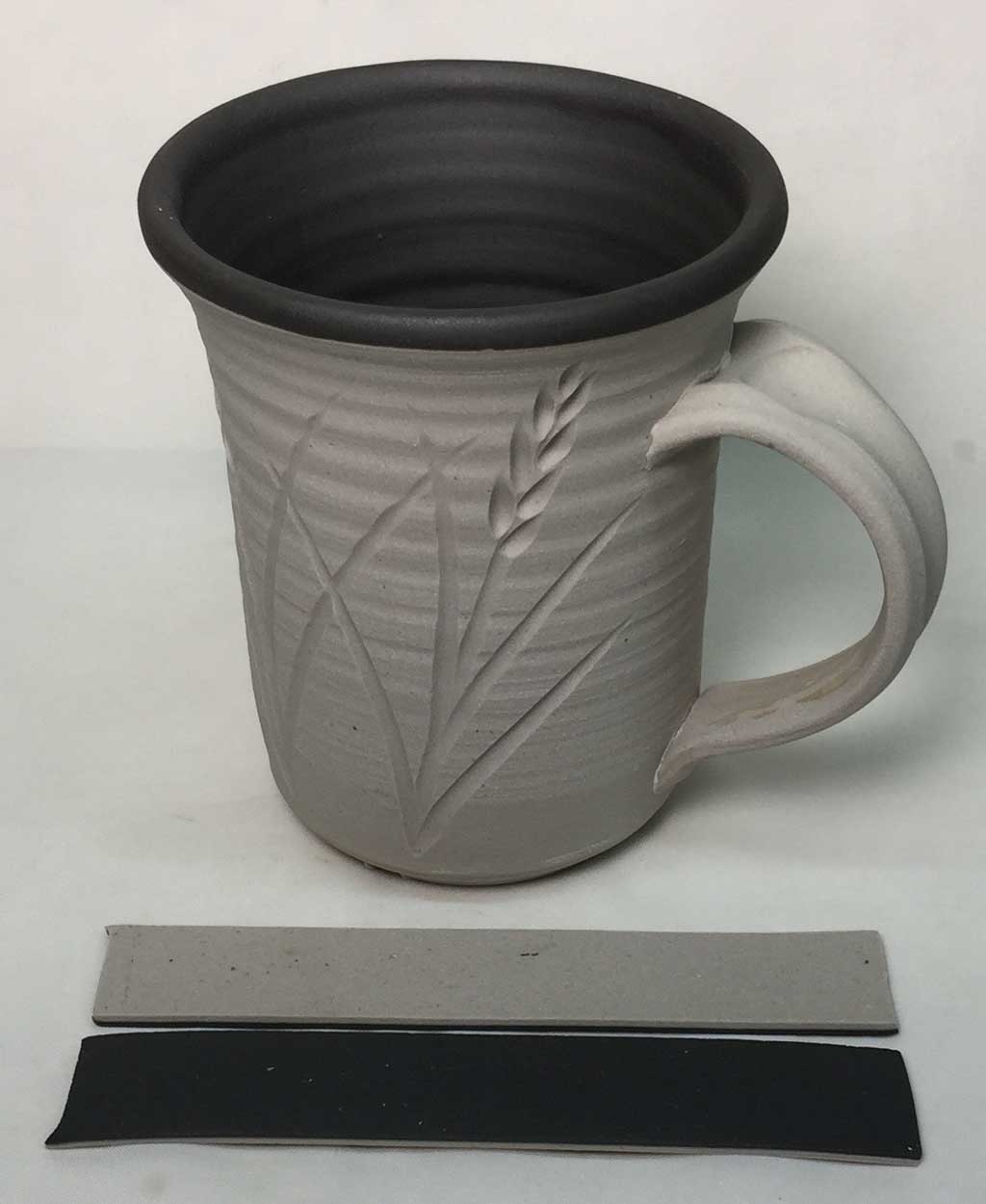| Monthly Tech-Tip | No tracking! No ads! | |
L3954J black engobe on a cone 10R whiteware body
The body is Plainsman H570 (0.5-1% porosity). This piece is not glazed. The firing schedule is C10RPL. Notice the EBCT test bars in front (engobe compatibility). These sandwich the body and the L3954J engobe together in a thin strip, differences in fired shrinkage curl the bar during firing (toward the one of higher shrinkage). The straighter the bars fire the better the fit. My regular engobe for use on our buff stoneware, L3954N (Plainsman H550, 2-3% porosity), has lower fired shrinkage than this (since that body is less vitreous). This one increases that shrinkage (with 5% more nepheline syenite, 5% less silica and 3% less ball clay). This employs 10% Mason 6600 stain to produce the jet-black fired product. 6600 is their cobalt black stain but the 6666 cobalt-free one should also work, both are suitable as body stains and recommended to 2300F (1260C) - cone 10 is technically above this limit but we have not encountered issues.
Related Pictures
How to make a black cone 6 oxidation clay body

This picture has its own page with more detail, click here to see it.
Many cone 6 black clay bodies are available commercially. Some manufacturers are using manganese dioxide but the fume hazards seem far too serious to risk. Is it practical to slurry up your own from a recipe? Yes. Probably the most common method is the addition of raw umber or burnt umber. Umber behaves as a flux so when added to middle temperature bodies the resulting clay becomes too vitreous (so warping, bloating and glaze blisters are common). The secret is too add the umber to a cone 10 stoneware and the umber fluxes it to a cone 6 stoneware. Another method is the use of a black stain. Stains carry no danger of bloating and they work really well. However, the elephant in the room here is cost (that’s also why cobalt is not even on the table). But there is a way to make black stain affordable: Using a jet-black engobe.
All these bars were fired to cone 6 (although they are numbered 5).
Top bar: L4768D, a white cone 10R porcelain with 10% umber (the result is too vitreous and colour has gone brown).
L4768E is a cone 10 red burning stoneware stained with 5% umber. The red fireclay in its recipe is the secret of it being sufficiently refractory to host the umber.
L4484D is MNP plus 6% Mason 6666 black stain. Normally more stain would be needed if it were a white burning porcelain.
P6729 and P7159 are both Plainsman Coffee clay, it is made using 10% burnt umber.
Absolutely Jet-Black Cone 6 Engobe on M340
This could also be super white

This picture has its own page with more detail, click here to see it.
This is the L3954B engobe. 15% Mason 6600 black body stain has been added (instead of the normal 10% Zircopax used for white). Of course, a cover glaze is needed for a functional surface. We put a lot of development work into producing a recipe fits this body, M340. It works even when thickly applied because it has the same fired maturity as the body. Lots of information is available on using L3954B (including mixing and adjustment instructions). Engobes are tricky to use, follow the links below to learn more. L3954B is designed to work on regular Plainsman M340 (this piece), M390 and Coffee Clay. Most important we document how to adjust its maturity, and thus firing shrinkage, to fine tune fit if needed. These bodies dry better than porcelains and are much less expensive, so coating them with an engobe to get a surface like this makes a lot of sense. Ed Phillipson discovered this 80 years ago, enabling selling pieces made from these clays as white hotel ware.
The best way to make black clay: Don't.

This picture has its own page with more detail, click here to see it.
To prove that using an engobe is the best way to make a black cone 6 stoneware clay surface consider the mug on the left, a version of L4768E. This is not the best way but it is the one most used (and what Plainsman Clays does with Coffee Clay). This is a DIY mix, the darkest that it is practical (I used the hyper-red burning C-Red clay as a base, thus needing much less umber to darken it). While it looks black beside red burning bodies, beside this true black it doesn't, First, it is not a body, it is just a thin veneer of stained porcelain engoben (if the surface is all we see why stain it all the way through?). That being said, some people need a totally black and safe clay, like this one, and can afford to make it themselves (if that is you try using the L4053B recipe as a starter). Get a plaster table and a propeller mixer and you will be unstoppable!
What about using metal oxides to make the engobe? Black stain is expensive but is far superior (and safer) for black. Consider using 10-15% colorant in this 500g mug, which would require 50-75 grams of stain (~$5-8). 10% stain in an engobe applied in this thin layer likely needs only a few grams of stain (for pennies of cost). What about using a commercial black underglaze? There are normally vitreous, would stick to a kiln shelf and not cover evenly like this.
Videos
Links
| Materials |
Mason 6600 Black Stain
A cobalt-containing stain useful in bodies, engobes and glazes at a wide range of temperatures. |
Got a Question?
Buy me a coffee and we can talk

https://digitalfire.com, All Rights Reserved
Privacy Policy

